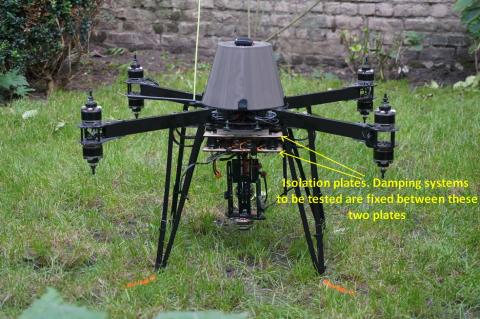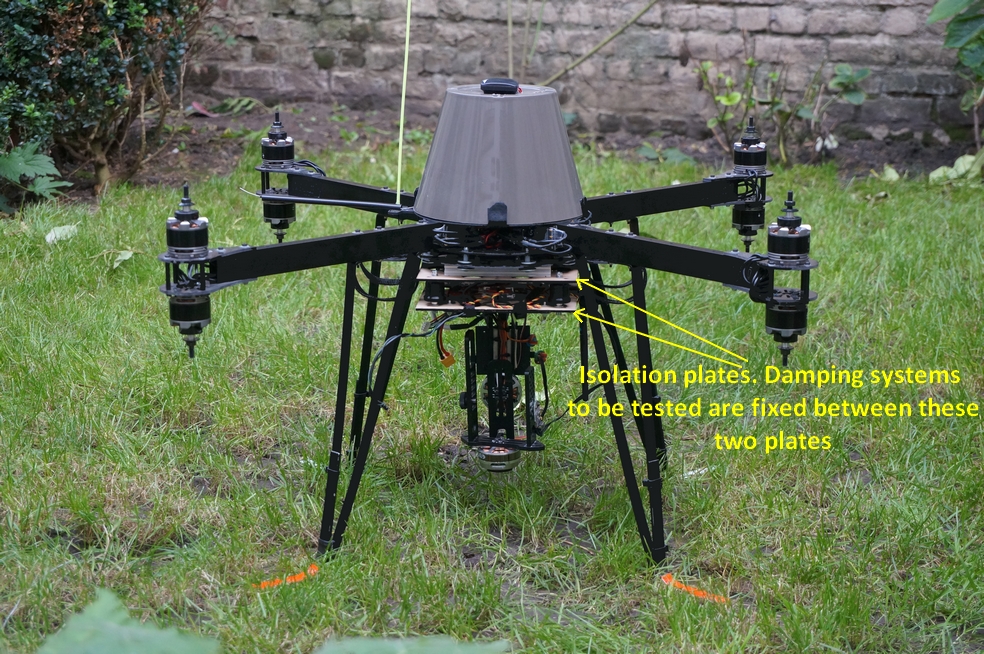
To optimize videophotography results, vibrations need to be reduced as much as possible. The objective is to disturb as little as possible a brushless gimbal holding a camera. (we all know too well how hard it is to get a brushless gimbal well tuned).
As most people, brushless gimbal tuning is done on the bench using accelerometers & gyros of the brushless gimbal's IMU. And like most, we do not get as good results when flying. Why?: frame & air vibrations. Frame vibrations are created by motors, props and wind. Direct air vibrations (external wind) also impact the brushless gimbal.
This is a blog post showing anti-vibrations objective measurements of different isolation systems, obtained on my Mr. Grey X8 workhorse shown on the introductory picture. All vibrations measurements are made during periods of min 30 sec of hover in stabilize mode. Take-off and landing periods are excluded of measurements.
Configuration of the test craft:
-Pixhawk controlled -Stabilize mode
-T-Motors MT3515-400Kv
-15x5 XOAR props
-6S batteries
-2 axis brushless gimbal - Alexmos
-Sony NEX5 camera
-Weight of the gimbal+camera+fpv+3S 1ah battery : about 1250 g
-AUW : about 6.8Kg

Vibrations measurement setup:
-All tests were made with the craft configured fully ready-to-film : except the gimbal which remained off not to measure its own generated vibrations. The camera was thus simply screwed on the gimbal with no power to the brushless motors.
-X-Cam vibration measurement tester
 X-Cam is installed on the different areas of the craft to be tested. Its mesaurements are triggered remotely by a PWM pulse (on/off switch allocated on Taranis). It is powered directly through the PWM servo cable connected on the receiver.
X-Cam is installed on the different areas of the craft to be tested. Its mesaurements are triggered remotely by a PWM pulse (on/off switch allocated on Taranis). It is powered directly through the PWM servo cable connected on the receiver.
Data are stored on board its flash memory. It is made for vibrations measurements in the 0-200Hz range and can store up to 3 min of continuous measurements.
Through the X-Cam GUI , data is downloaded from the flash memory to produce a time graph (basically useless as it shows the X-Y-Z vibrations measurements along the time axis), and a frequency graph showing X,Y,Z vibrations amplitudes (in number of g) versus frequency (in Hz). Raw data or weighted averaged data can be calculated.
Two anti-vibration systems were measured,
First a silicon ring system as shown below,
 Four of these were used in a X configuration between Mr Grey's two plates (see introductory picture). Each plate is made of plywood; square shaped with 20 cm long sides.
Four of these were used in a X configuration between Mr Grey's two plates (see introductory picture). Each plate is made of plywood; square shaped with 20 cm long sides.
Silicon rings come in two stiffnesses: red for softter silicon, black for stiffer silicon. Here, only the red softer ones were tested. Each Secraft system costs about 9 euros each (www.secraft.net) , which is relatively cheap.
Second tested system is a "Bell" shaped precompressed silicon system. Each "Bell" is made for a 250g payload. Each one of them costs about 39 euros (www.altigator.com) which is quite expensive. It is mostly used in high end professional aerial photography rigs :
Four of those were used, in each corner in between Mr Grey's test plates as shown below:
Reference measurement:
In order to compare results, a reference measurement is made on the frame itself, with the X-Cam placed at the center of Mr Grey's top plate, under its protective "flower pot".
 Frequency domain picture shows two frequencies were vibrations are significant : 85Hz and 175Hz; The measurements show about 0,3g of vibrations on all three axis at 85Hz; and 0,4-0,5 g vibrations at 175Hz.
Frequency domain picture shows two frequencies were vibrations are significant : 85Hz and 175Hz; The measurements show about 0,3g of vibrations on all three axis at 85Hz; and 0,4-0,5 g vibrations at 175Hz.
First test result with Silicon rings system:
X-Cam is now placed on the second bottom plywood plate on which the gimbal is fixed,
![]() The results show that frame vibrations are continuing to pass through to the gimbal at the same frequencies (85Hz and 175 Hz) but amplitudes are divided by a factor of 10 at 85 Hz and almost by a factor of 20 at 175Hz, versus non damped frame vibrations.
The results show that frame vibrations are continuing to pass through to the gimbal at the same frequencies (85Hz and 175 Hz) but amplitudes are divided by a factor of 10 at 85 Hz and almost by a factor of 20 at 175Hz, versus non damped frame vibrations.
Second test with the "Bell" system:
X-Cam is placed at the exact same location as for the first test,
![]() The results show that frame vibrations are continuing to pass through to the gimbal at the same frequencies (85Hz and 175 Hz) but amplitudes are divided by a factor of 2 at 85 Hz and by a factor of about 2 at 175Hz, versus non damped frame vibrations.
The results show that frame vibrations are continuing to pass through to the gimbal at the same frequencies (85Hz and 175 Hz) but amplitudes are divided by a factor of 2 at 85 Hz and by a factor of about 2 at 175Hz, versus non damped frame vibrations.
If we show the silicon ring's system on a graph at the same scale as Bell's system:
![]() The silicon ring anti-vibes system literally erases vibrations in comparison with the "Bell" anti-vibe system....
The silicon ring anti-vibes system literally erases vibrations in comparison with the "Bell" anti-vibe system....
Comparison of both anti-vibrations systems:
It appears clearly that the "silicon ring system" is much more efficient at reducing vibrations versus the "Bell" system. Further, this silicon ring system is much cheaper than the Bell system.
For once, more expensive, supposedly professionnal parts were not up to the task versus cheaper diy parts.

